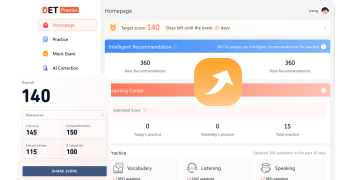掌握 Duolingo 英语测试的“读,然后说”部分
Duolingo 英语测试是一种方便且经济实惠的在线评估您英语水平的方法。与其他标准化考试不同,Duolingo 英语测试具有独特的格式,可根据您的水平和技能进行调整。考试中最具挑战性和重要的部分之一是“Read, Then Speak”部分,在阅读提示后,您需要就某个主题进行90秒的讲话。
在本文中,我们将向您展示如何在这一部分取得成功并提高会话和制作的分数。
我们将涵盖:
- 理解“Read, Then Speak”格式
- 准备回答
- 结构化您的回答
- 传达您的回答
- 增强您的回答
- 结合示例问题和演示答案
- 练习技巧和资源

理解“Read, Then Speak”格式
“Read, Then Speak”部分是 Duolingo 英语测试中的四种口语任务之一。它要求您“就下面的话题讲90秒。”
对于这种问题类型,您将在屏幕上看到一个书面提示。您有20秒的时间来阅读提示并准备您的回答。然后,测试将自动进入录音屏幕,您将有90秒的时间来讲述您的回答。在您讲话时,您仍然可以看到提示。
提示通常会要求您谈论个人经历、意见或偏好。例如:
- 谈谈您最喜欢的餐厅。
- 讨论一次您必须做出艰难决定的时刻。
- 描述您喜欢的一项爱好。
提示还将包括一些要点以指导您的回答。例如:
- 它在哪里?
- 它提供什么类型的食物?
- 您多久去一次?
- 为什么它是您的最爱?
您的回答将根据两个子分数进行评分:会话和制作。会话衡量您如何与问题互动并表达您的想法。制作衡量您如何使用词汇和语法清晰而准确地交流。
准备回答
成功回答的关键在于快速理解提示并在短时间内组织您的想法。以下是一些帮助您准备的策略:
- 仔细阅读提示,确定主要话题和子话题。例如,如果提示是“谈谈您最喜欢的餐厅。”,主要话题是您最喜欢的餐厅,子话题是它在哪里,它提供什么类型的食物,您多久去一次,以及为什么它是您的最爱。
- 想一个与主要话题相关的具体例子。例如,如果您最喜欢的餐厅是离您家很近的泰国餐厅,想起一次您与朋友或家人一起去那里的难忘时刻。
- 用要点作为指导来构建您的回答。例如,您可以先介绍您最喜欢的餐厅,然后按顺序谈论每个要点,最后以总结您的主要观点结束。
- 有效地使用20秒的准备时间。您可以找到一些关键词来帮助您记住您的主要观点。您还可以练习说出回答的第一句话,以便自信地开始。
结构化您的回答
清晰而逻辑的回答结构将帮助您流畅而连贯地传达您的回答。以下是一些帮助您构建回答的技巧:
- 创建一个引言、主体和结论。您的引言应简要介绍主要话题并陈述您的主要观点。您的主体应通过详细讨论每个子话题来发展您的主要观点。您的结论应总结您的主要观点并以最后的评论结束。
- 使用过渡词和短语来连接您的想法和句子。例如,您可以使用诸如“first”, “second”, “third”, “next”, “then”, “finally”, “also”, “however”, “for example”, “in conclusion”等词语。
- 解决提示的所有部分。确保您不要跳过或忽略任何要点。如果您对一个子话题没有什么可说的,可以简单地承认它然后继续。例如,您可以说“I don’t go there very often, but when I do, I always enjoy it.”
- 专注于主题。不要跑题或提及不相关的细节。如果您发现自己偏离了主题,请将自己带回到主要观点和要点。
传达您的回答
您的表达与内容同样重要。以下是一些帮助您清晰流畅地传达回答的技巧:
- 自然清晰地说话。使用正常的说话速度和音量。不要说得太快或太慢,太大声或太轻声。正确发音,不要含糊不清或含混不清。
- 使用多样化的词汇和结构。不要反复重复相同的词或句子。使用同义词、反义词或改写来以不同方式表达相同的想法。使用各种词汇和语法结构来展示您的熟练程度和准确性。
- 合理管理您的时间。您有90秒的时间来讲述您的回答,这足以覆盖提示和要点。不要说得太长或太短。如果在时间用完之前完成了回答,可以添加一些额外的细节或例子来详细说明您的观点。如果时间不够,可以快速总结您的回答。
- 使用多变的语调和重音。不要用单调或平淡的声音说话。使用音调、音量和重音的变化来传达含义和情感。强调句子中的重要词语或短语。使用上升和下降的语调来表示问题和陈述。
增强您的回答
为了让您的回答脱颖而出并给评分者留下深刻印象,您可以使用一些策略来增强您的回答并展示您的会话技能。以下是一些方法:
- 使用修辞性问题。修辞性问题是您问自己或听众的问题,但不期待回答。它们用于吸引听众,表达您的想法或强调一个观点。例如,您可以说“Who doesn’t love Thai food, right?” or “What could be better than that?”
- 使用轶事或故事。轶事或故事是关于个人经历或事件的简短有趣的描述。它们用于说明您的观点,提供例子或增加幽默。例如,您可以说 “One time, I ordered the spiciest dish on the menu, and I regretted it so much. My mouth was on fire, and I had to drink three glasses of water to cool it down.”
- 使用意见或感受。意见或感受是您对某个主题的个人看法或情感。它们用于展示您的个性、观点或态度。例如,您可以说“I think Thai food is the best cuisine in the world.” or “I feel so happy and relaxed when I go to my favorite restaurant.”
示例问题和演示答案
为了让您更好地了解如何应用我们讨论的技巧和策略,让我们来看一个“Read, Then Speak”部分的示例问题和演示答案。
示例问题:
Discuss a time when you had to make a difficult decision.
What was the situation?
What choices were available to you?
Why did you make the decision you did?
演示答案:
Well, I’d say one of the toughest decisions I’ve ever had to make was figuring out where I wanted to go to college after I finished up high school. I had gotten accepted to a few different schools and it definitely wasn’t an easy choice to make.
Let’s see, first off, I should probably give you some background real quick on the different colleges I got into. There was this small liberal arts college pretty close to home that I applied to. It was a nice little school. Then there was this huge state university that was like 5 hours away – it was really big with tons of students. And last, I applied to this Ivy League school all the way on the other side of the country. I had worked really hard to get awesome grades and test scores in high school so I could have some good options to choose from.
So each school had their own pros and cons that I had to think about. The small college was nearby and I already knew some kids going there. But it didn’t have the big name like the Ivy League did. The state school was a lot more affordable but it was so big I worried I wouldn’t get enough personal attention from professors. And the Ivy League school was super prestigious, but way more competitive and expensive too.
After visiting all 3 campuses, I decided the small liberal arts college was the best option for me. I really liked the small class sizes and how tight-knit the community felt. They also gave me a great financial aid package that made it possible to afford. I knew I’d get to work closely with professors and get individualized attention there, and that was huge for me.
So in the end, I went with my gut telling me the small school was the right call. I didn’t want to pass up the chance to really get mentored and be part of a community just because the Ivy League name carried more weight. And I’m stoked with my choice – I’ve gotten to have experiences at this school I don’t think I would’ve had anywhere else. So for me, I’m happy with my decision.
练习技巧和资源
提高口语技能并为“Read, Then Speak”部分做准备的最佳方法是定期和一致地练习。以下是一些帮助您练习的方法和资源:
- 模拟测试环境。尽量重现实际测试的条件。使用带有网络摄像头和麦克风的计算机,并找到一个安静舒适的地方进行测试。设置一个计时器,20秒阅读提示,90秒讲述回答。录制自己并听取自己的表现。找出您的优点和缺点,并努力改进它们。
- 使用在线资源。许多在线资源可以帮助您练习口语技能并为 Duolingo 英语测试做准备。例如,您可以使用官方 DET 网站了解更多有关测试格式、评分和提示的信息。您还可以使用我们的Duolingo 英语测试练习题库来熟悉测试。
点击这里了解更多 DET 准备策略
寻找 DET 的提示?请在这里查看:https://www.detpractice.com/category/pro-test-tips/
立即注册我们的DET 题库免费开始练习。






